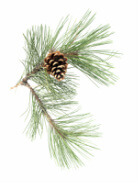MNFarmHunter
Well-Known Member
Quick back story to give context:
Looking for a winter hobby and being rebitten by the muzzleloader bug, I broke out the leather tools and started leatherworking and started the thread here:
Continuing down that rabbit hole, I've gone all in on 1700's hunting/bushcraft/tradescraft...with the caveat that I'm looking for the finished product while learning new skills without necessarily going full colonial, thus the name "New Age traditional/colonial tradecraft". This goes beyond simply leatherworking and goes into blacksmithing, textiles, camping, etc. while using what we all have available around the house to get there.
In the end, the goal of this thread is to bring together different traditional skills that anyone can do with stuff you probably have around your house or at the local hardware store. In my short adventure so far, I've already "discovered" that many products my family use around the house or while camping/hunting/outdoors activities can be made yourself for cheaper along with the pride that you made it yourself. Essentially, all useful skills to learn and pass on to future generations.
Once I pull photos off the phone (so much for colonial), I'll individually post how-to's for different things. Please feel free to post your own that you've done.
Looking for a winter hobby and being rebitten by the muzzleloader bug, I broke out the leather tools and started leatherworking and started the thread here:
Leatherworking Thread
This is the thread for questions, tips and humble (or not so humble) brags. I got bit by the muzzleloader bug this fall which naturally means I had to break out the leatherworking tools to make the necessary accouterments for muzzleloaders. Here's what I've made for the past few days...
saddlehunter.com
Continuing down that rabbit hole, I've gone all in on 1700's hunting/bushcraft/tradescraft...with the caveat that I'm looking for the finished product while learning new skills without necessarily going full colonial, thus the name "New Age traditional/colonial tradecraft". This goes beyond simply leatherworking and goes into blacksmithing, textiles, camping, etc. while using what we all have available around the house to get there.
In the end, the goal of this thread is to bring together different traditional skills that anyone can do with stuff you probably have around your house or at the local hardware store. In my short adventure so far, I've already "discovered" that many products my family use around the house or while camping/hunting/outdoors activities can be made yourself for cheaper along with the pride that you made it yourself. Essentially, all useful skills to learn and pass on to future generations.
Once I pull photos off the phone (so much for colonial), I'll individually post how-to's for different things. Please feel free to post your own that you've done.













